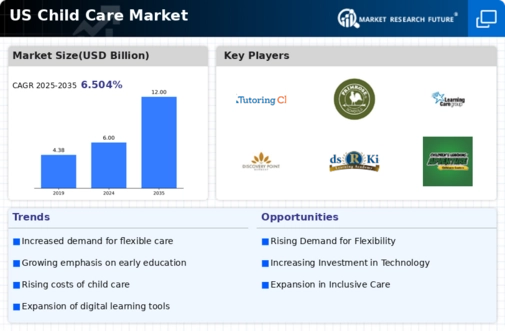Government Support and Funding
Government initiatives play a crucial role in shaping the child care market. Recent legislative measures have aimed to increase funding for child care programs, thereby enhancing accessibility for families. For instance, the Child Care and Development Block Grant (CCDBG) provides substantial financial assistance to low-income families, which can significantly impact their ability to afford quality child care. In 2025, funding levels are projected to rise, potentially increasing the number of families benefiting from these programs. This influx of government support not only aids families but also encourages the establishment of new child care facilities, thereby expanding the market. As funding continues to evolve, the child care market may witness a transformation in service delivery and quality, ultimately benefiting children and parents alike.
Rising Workforce Participation
The child care market is experiencing growth due to the increasing participation of parents in the workforce. As more individuals, particularly women, enter the labor force, the demand for reliable child care services intensifies. According to recent data, approximately 70% of mothers with children under 18 are employed, which underscores the necessity for accessible child care options. This trend is likely to continue, as economic conditions improve and more families seek dual-income households. Consequently, the child care market must adapt to accommodate this rising demand, potentially leading to the expansion of facilities and services that cater to working parents. The need for flexible hours and diverse care options is becoming paramount, indicating a shift in how child care services are structured and delivered.
Demographic Shifts and Diversity
Demographic changes within the population are significantly impacting the child care market. The increasing diversity of families, including varying cultural backgrounds and family structures, necessitates a broader range of child care options. Providers are recognizing the importance of offering culturally relevant programs that cater to the unique needs of different communities. In 2025, it is anticipated that the demand for bilingual and multicultural child care services will rise, reflecting the growing diversity in the U.S. population. This shift presents both challenges and opportunities for the child care market, as providers must adapt their services to remain competitive. By embracing diversity and inclusivity, the child care market can better serve families and foster an environment that supports all children.
Growing Awareness of Child Development
There is a heightened awareness regarding the importance of early childhood development, which is influencing the child care market. Research indicates that quality early education can lead to improved cognitive and social outcomes for children. As parents become more informed about these benefits, they are increasingly seeking child care services that prioritize developmental activities and educational curricula. This trend is reflected in the rising demand for programs that incorporate structured learning alongside traditional care. In 2025, it is estimated that around 60% of parents will prioritize educational components in their child care choices. This shift is likely to drive innovation within the child care market, as providers adapt their offerings to meet the evolving expectations of parents.
Technological Advancements in Child Care
The integration of technology into the child care market is becoming increasingly prevalent. Providers are adopting various technological tools to enhance communication with parents, streamline operations, and improve the overall quality of care. For instance, many facilities now utilize apps for real-time updates on children's activities, which fosters transparency and builds trust with parents. Additionally, technology is being leveraged for educational purposes, with interactive learning tools being introduced in child care settings. As of 2025, it is projected that approximately 40% of child care centers will incorporate some form of technology into their curriculum. This trend not only modernizes the child care experience but also aligns with the expectations of tech-savvy parents, potentially reshaping the landscape of the child care market.

















Leave a Comment